Visibility of Jumadal Thani Crescent
(1430 AH)
- When to Observe Jumadal Thani Waxing (NEW) Crescent ?
- Jumadal Thani Waxing (NEW) Crescent Observation Results
- The OFFICIAL First Day in Different Countries
- When to Observe Jumadal Awwal (OLD) Crescent ?
- Jumadal Awwal Waning (OLD) Crescent Observation Results
The geocentric conjunction (Geocentric New Moon) will occur Inshalla on (Sunday 24 May 2009) at 12:11 UT.
Sighting the new crescent on (Sunday 24 May 2009) and (Monday 25 May 2009) is shown in the below graphs using the program Accurate Times by Mohammad Odeh according to Odeh criterion. Where:-
According to the Universal Hejric Calendar (UHC), which is based on the calculated crescent visibility, the start of this month in the Eastern Region will be on Tuesday 26 May 2009 and in the Western Region will be on Monday 25 May 2009.
- Results of seeing the crescent, and the first day of the month in different countries will be added here Inshalla as we receive the reports from ICOP's members. If you wish to be a member in ICOP, or to know more about it, kindly click here.
So far, the earliest sighting of the crescent -after sunset- was on Sunday 24 May 2009 from USA by ICOP member Mr. Jim Stamm.
Sunday 24 May 2009:
Location = Tucson, Arizona (USA)
Surface conditions at time of first/last sighting at
Topocentric and local time values from “Accurate Times”:
Crescent first observed through 8” SC telescope:
Final observation with telescope:
This was a difficult observation. The crescent never got as distinct as my record time observation. Initial view (19:29) was about 10 degrees in arc length. 15° at 19:31; Hints of extensions at 19:34; 40°-50° at 19.36; I could not see the entire arc at once. I had to scan with my eye. However, the entire arc was illuminated, some sections brighter than others. 60° at 19:40; 70° at 19:42; 80° at 19:43; 90° at last observation (19:45). The brightest part of the illuminated arc was not visible until about halfway into the observation. I did not realize the significance of this phenomenon at the time, and did not time its appearance. I do not know if the "bright" section of the arc (a few degrees at most) was due to albedo, or an illusion due to surface features - i.e. a wider part of the arc."
Monday 25 May 2009:
Location: Esfahan , Iran
Observer & photographer: Alireza Mehrani
Date: Saturday May 25, 2009 (Khordad 4, 1388)
Topocentric and local time values from "Moon Calculator" (Refrac off):
We saw the new moon crescent on Monday May. 25th .2009(04/3/1388 according to Iran calendar), in a region located in the east of Shahreza with these geographic coordinates:
The first observation of crescent parameters:
The first observation of crescent parameters:
The group was divided two and all of them observed the crescent
Details report are given in bellow -
Persons:
Monday 25 May 2009:
Tuesday 26 May 2009:
The geocentric conjunction (Geocentric New Moon) will occur Inshalla on (Sunday 24 May 2009) at 12:11 UT.
Sighting the OLD crescent on (Sunday 24 May 2009) and on (Saturday 23 May 2009) is shown in the below graphs using the program Accurate Times by Mohammad Odeh according to Odeh criterion. Where:-
Sunday 24 May 2009:
Saturday 23 May 2009:
Location: Esfahan, Iran
Observer & photographer: Alireza Mehrani
Date: Saturday May 23, 2009 (Khordad 2, 1388)
Topocentric and local time values from "Moon Calculator" (Refrac off):
When to Observe Jumadal Thani Waxing (NEW) Crescent ?



Jumadal Thani Waxing (NEW) Crescent Observation Results
Longitude = 110.9645 W
Latitude = 32.4204 N
Elevation = 842 meters
Time Zone = -7.0 hours
Tucson International Airport (805 m):
Temperature = 84 degrees F
Relative Humidity = 13 percent
Sea Level Pressure = 1007 mb
Scattered clouds, but not a problem.
Sunset (at sea level) = 19:27
Moonset (at sea level) = 20:13
Time from new moon at 19:47 = 15 hr. 36 min.
Moon lag time = 46 min.
Relative Altitude = 8.27 degrees
Elongation from sun = 8.28 degrees
Crescent width = 10 arc seconds
Illumination = 0.52 percent
Time = 19:29
Altitude = 5.9 degrees
Time = 19:45
Altitude = 3.0 degrees
Latitude: 32° 37' N
Longitude: 51° 35' E
Elevation: 1627 meters from sea level
Time zone: +4.5
Optical tools: Digital camera (Sony DSC H9)
Temperature: 31 C°
Barometer: 838.5 mb
Wind: 21.6 km/h
Humidity: 13%
Visibility: 10 km
Time: 20:37 LT (16:07 UT)
Moon Alt: 7° 30' 29"
Sun Alt: - (7° 18' 38")
Elongation: 15° 33' 34"
Rel Azi: - (4° 45' 27")
Moon Width: 0.61'
Moon Phase: 2.07%
Moon Age: 27h 56m after conjunction
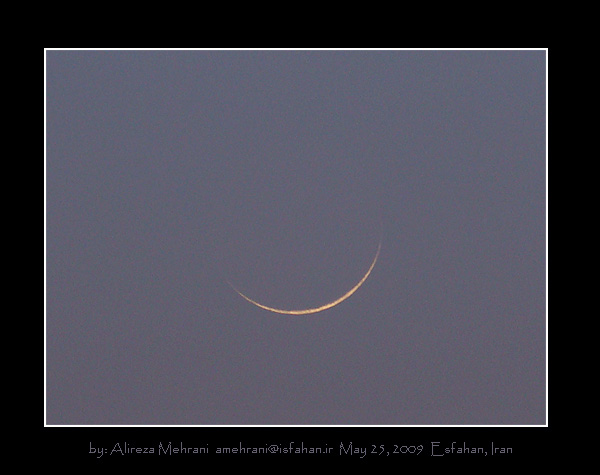
From: The Astronomy and Geophysics Centre Of Shahreza & Women Astronomy and Geography Society of Isfahan Province
Reporter: Hossein Janghorbani, manager of the center
Lat: 32° N
Lon: 51° 52' E
Ele: 1825 m
Time Zone: +3.5
By: Ali Janghorbani
Through: 15x70 binocular
Time: 20:01 LT
Moon Alt: 13.661
Elongation: 15.228
Moon Phase: 1.99%
Moon width: 0.58m
Rel Azi: -3.555
Moon Age: 27h 21m
By: Ali Janghorbani & Meysam Safian
Through: eye
Time: 20:10 LT
Moon Alt 11.982
Elongation: 15.310
Moon Phase: 2.01%
Moon width: 0.59m
Rel Azi: -3.812
Moon Age: 27h 30m
The group members:
1. Davood Javeri
2. Mohammad Javad Nikeghbal
3. Meysam Safian
4. Reza Janghorbani
5. Ali Janghorbani
6. Hossein Janghorbani
7. Zhila Taghavi
8. Arezoo Tabibian
9. Zahra Fallah


local sunset 18:41
first seen with 8'' telescope 19:02 (21 minutes after sunset)
first seeb with 20*60 bino 19:08 (27 minutes after sunset)
first seen with naked eyes 19:10 (29 minutes after sunse)
last seen with naked eyes 19:17 ( only for 7 minutes)
last seen with 20*60 bino 19:25 ( 35 minutes before moonset)
last seen with 8" telescope 19:32 ( 30 minutes before moonset)
local moonset 20:02
T moon age 25H 56M G. moon age 27H 30M
T Elong 15.3 deg
Moon Alt 13.9 deg
lag time 81 minutes "
1. Imam Adelakun Daud
2. Mukadam Abdul-Azeez
3. Adnan Abdul-Rasaq (9yrs)
to the site of the searching fortunately Chief Imam Of Ikorodu (Alh Seifu deen Olowo Oribi ) and his entourage was unable to Meet us at the site due to the logjam of that day. At the same time we called our colleques in Bauchi State they said the sky is cloudy, and we called the Sultonu Spokesman ( Professor Gwandu) 7:28 p.m. he too said the sky in Sokoto state is cloudy. Anyway we will try searching today too. Happy Jumada thanni Today 26-05-09."
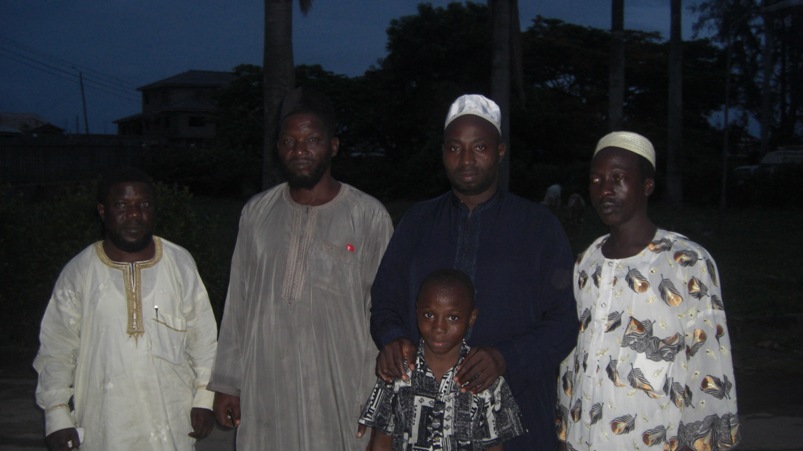
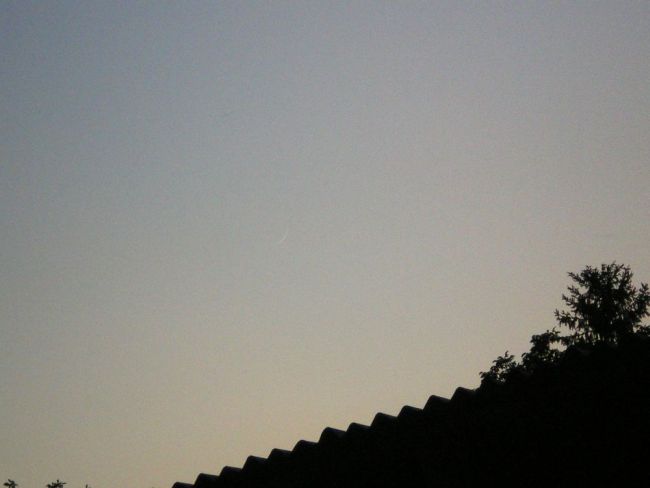
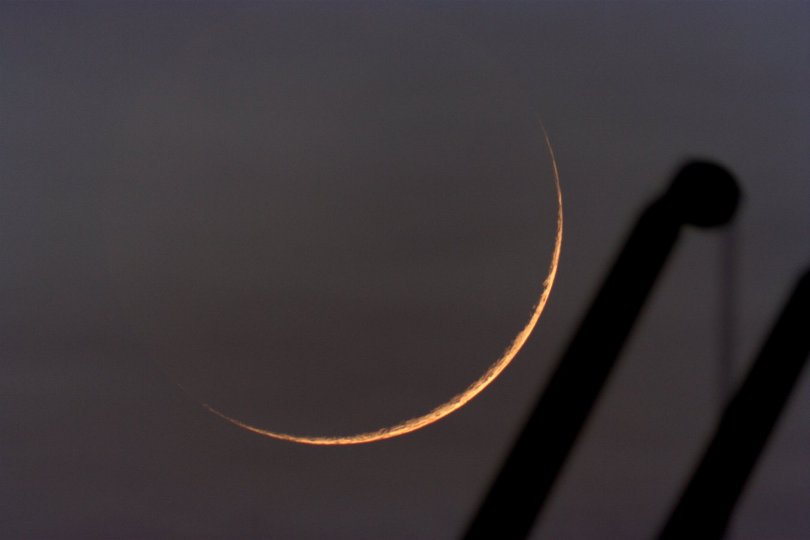
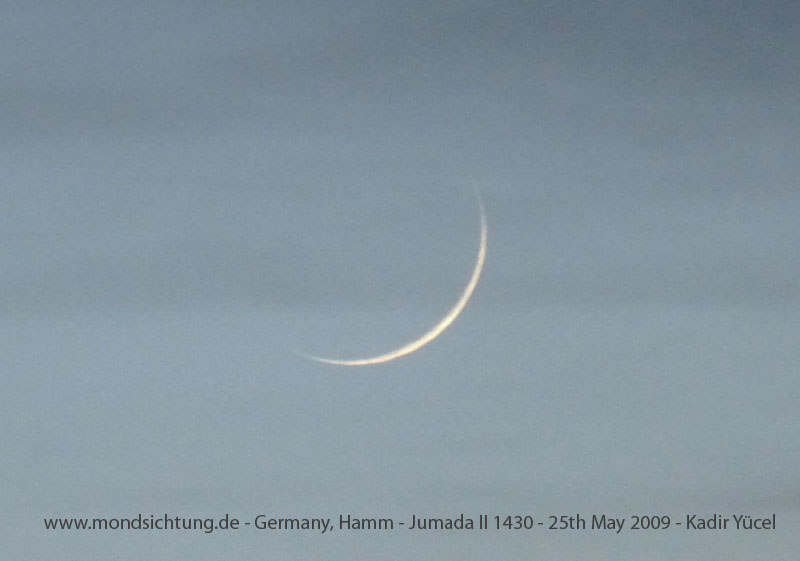
London Eye Team included:
Mohamed Ali (CEO, Islam Channel TV)
Talat Sultan (Producer, Islam Channel TV)
Two Camera Men (Islam Channel TV)
Ajmal Masroor (London)
Shaykh Sulayman Gani (London)
A Rashid Bhatti (Slough)
Imam Inayat Ullah (London)
Aziz Ahmad (Harrow)
Hafiz Ahmad Mismillah (Southall)
Abdul Sattar Shahid (Southall)
York Astronomical Society Team included:
Qamar Uddin (York AS)
Hatim Salih (York AS)
Maulana Hasib (Batley)
Maulana Imran Lunat (Bately)
Vashiullah (Bately)
Martin Dawson (York AS)
Glen Berry (York AS)
Barry Beckwith (York AS)"
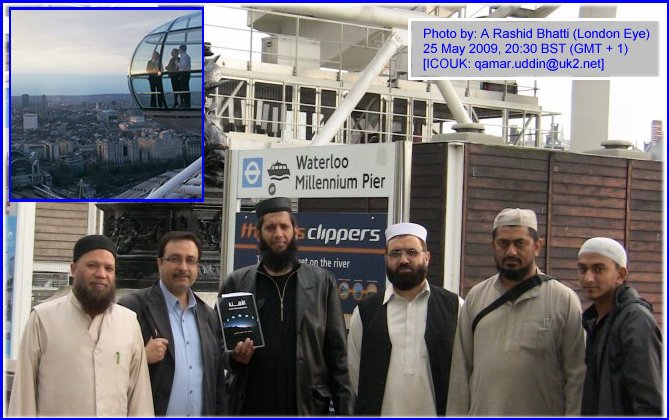

Moon Sighting Report From Sweden
Month: Mahe Jumada-al-Thani 1430 Hizri
Sighting of the Crescent Moon: Very clearly seen by bare eyes
Place of Sighting: Varby Gard Hill, Stockholm, Sweden (Near subway station)
Time of Sighting: After Magrib Prayer (21:55-22:50)
Time of first sighting by Muhammad Fakhrul Islam: 22:40
Date: 25th May 2009 Monday.
Condition of the sky: Very Clear and shinning
1. Muhammad shafiur Rahman Chowdury,
2. Saiyid Muhammad Nasiruddin Ahmad Shohel,
3. Muhammad Fakhrul Islam,"

The OFFICIAL First Day in Different Countries

When to Observe Jumadal Awwal Waning (OLD) Crescent ?

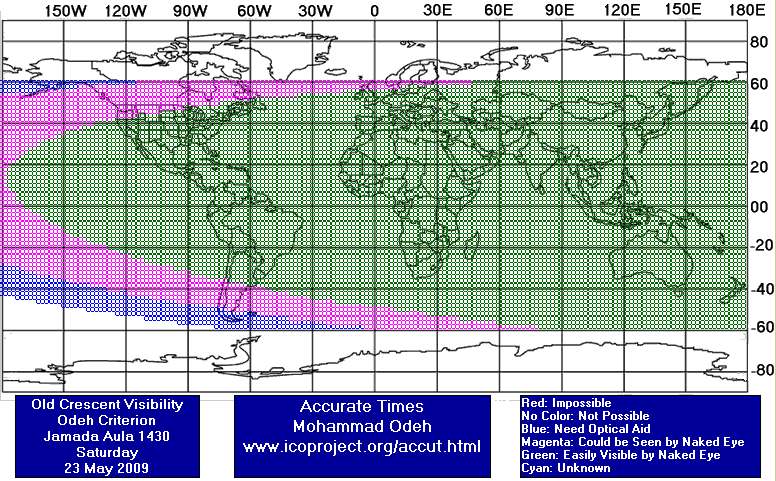

Jumadal Awwal Waning (OLD) Crescent Observation Results
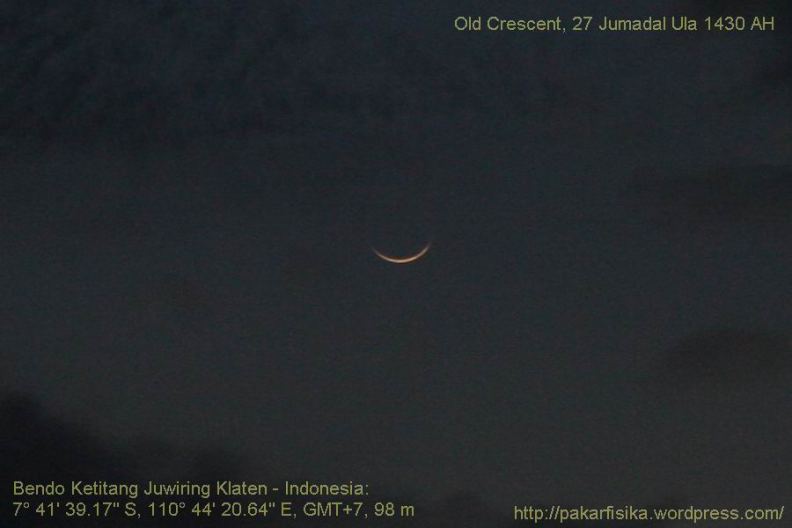
Latitude: 32° 37' N
Longitude: 51° 35' E
Elevation: 1627 meters from sea level
Time zone: +4.5
Optical tools: Digital camera (Sony DSC H9)
Temperature: 19.2 C°
Barometer: 846.9 mb
Wind: Calm
Humidity: 35%
Visibility: 10 km
Time: 05:38 LT (01:08 UT)
Moon Alt: 10° 50' 12"
Sun Alt: - (5° 03' 04")
Elongation: 19° 45' 11"
Rel Azi: 11° 47' 24"
Moon Width: 0.96'
Moon Phase: 3.20%
Moon Age: 35h 03m before conjunction

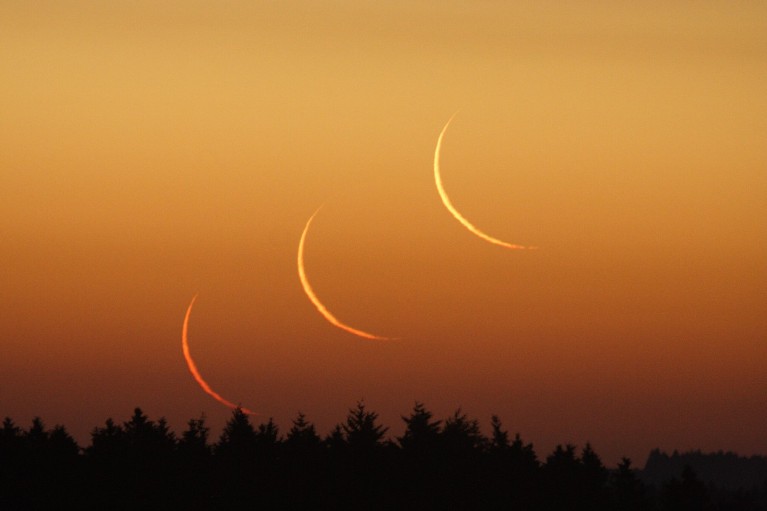
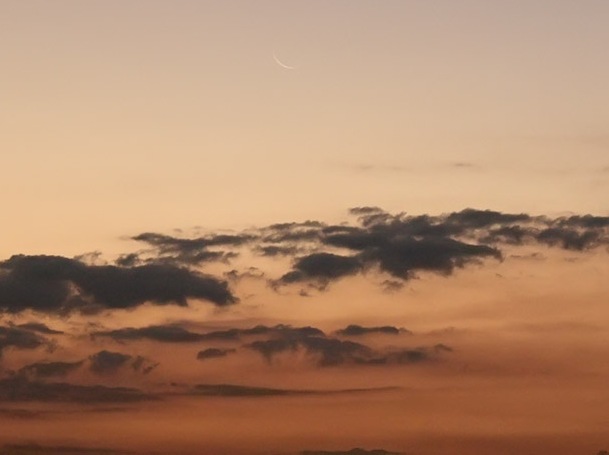
By Moh'd Odeh. Copyright © 1998-2009 Islamic Crescents' Observation Project (ICOP), All Rights Reserved. This material may not be reproduced in any form without permission. For more information Kindly send E-mail





